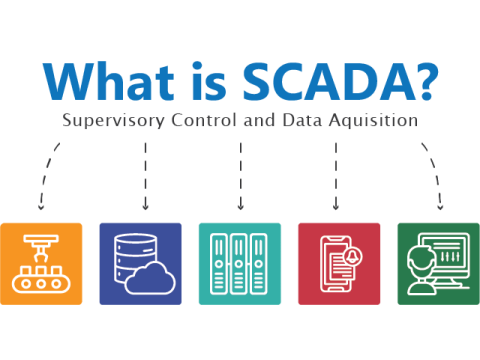SCADA (Supervisory Control and Data Acquisition) is a software-hardware framework designed for collecting, processing, visualizing, and archiving data from monitored or controlled processes. These systems have become indispensable in modern industrial settings, providing real-time oversight of equipment operations and enabling rapid decision-making. By offering operators and engineers a user-friendly interface for managing production workflows, SCADA significantly enhances safety, efficiency, and responsiveness across a wide range of applications.
Below, we examine the core architecture of SCADA systems, their operator interfaces, benefits for industrial processes, and promising directions for future development.
1. SCADA Architecture and Components
1.1 Hierarchical Levels
Typical SCADA architectures comprise multiple hierarchical levels:
- Field Level: Sensors, measuring instruments, and actuators that directly interact with the plant or process.
- Control Level: Programmable Logic Controllers (PLCs) or Remote Terminal Units (RTUs) that collect sensor data and issue commands to actuators.
- Supervisory Level: Operator workstations and Human-Machine Interfaces (HMIs) for process visualization and control.
1.2 Key Components
- RTUs (Remote Terminal Units): These gather operational data (e.g., pressure, temperature) and forward it to the central SCADA system. They also receive control signals (open a valve, adjust speed, etc.) from higher-level software.
- I/O Servers: Handle the flow of information from controllers to the SCADA database, ensuring data integrity and efficient updates.
- Database Servers: Store real-time and historical data, event logs, and operator actions for analysis, auditing, or compliance.
- Operator Workstations (HMI): Provide user-friendly dashboards for monitoring and controlling various aspects of the production process.
2. SCADA Interface (HMI)
2.1 Human-Machine Interface Design
The SCADA interface (often referred to as HMI) is created with ergonomics in mind – delivering critical process insights at a glance. HMI components typically include:
- Process Flow Diagrams: Graphical representations of system layouts and real-time status indicators.
- Trends and Charts: Visualizations of past and present data to help track performance and identify anomalies.
- Event/Alarm Logs: A chronological record of issues or abnormal conditions for prompt operator response.
- Pop-up Windows and Detailed Views: Deeper information on specific equipment or alerts.
2.2 Functional Capabilities
An HMI within a SCADA system enables:
- Real-Time Monitoring: View critical parameters such as temperature, pressure, and flow.
- Manual Control: Execute operator-driven commands that affect process conditions (e.g., toggling a pump on/off).
- Configuration and Setpoints: Adjust target values or operational limits.
- Historical Data and Reporting: Retrieve archived data, generate performance reports, or audit logs for troubleshooting and optimization.
3. Advantages of SCADA Implementation
3.1 Economic Efficiency
By integrating SCADA into industrial workflows, organizations often experience:
- Reduced Downtime: Real-time monitoring allows for quick detection and resolution of equipment malfunctions, lowering unplanned outages.
- Process Optimization: Fine-tuned control of production parameters decreases energy consumption and material waste.
- Minimized Human Error: Automated data collection and control reduce mistakes linked to manual intervention.
3.2 Enhanced Safety
SCADA bolsters safety through:
- Continuous Oversight of Critical Variables: Instantly spot abnormal conditions before they escalate.
- Automatic Protective Responses: Trigger emergency shutdowns or fallback procedures in crisis scenarios.
- Detailed Event Logging: Keep complete records of operator actions and system statuses for root-cause analysis.
4. Future Trends and Developments
Modern SCADA platforms increasingly incorporate cutting-edge technologies:
4.1 Cloud Computing
Leveraging cloud services fosters distributed control systems accessible from virtually anywhere, reducing on-premises hardware footprints. Cloud-based infrastructure also simplifies data backup, disaster recovery, and collaborative analysis among multiple sites.
4.2 Machine Learning and Predictive Analytics
By applying AI algorithms to production data, SCADA solutions can:
- Foresee Equipment Failures: Plan proactive maintenance, avoid breakdowns.
- Optimize Process Parameters: Continuously refine setpoints based on historical performance.
- Adapt to Changing Conditions: Automatically adjust operations for evolving market or environmental factors.
4.3 Mobile Integration
Smartphones and tablets now allow real-time access to SCADA interfaces – operators can monitor processes or respond to alarms whether in the control room or off-site. This mobility enhances response times and supports flexible, around-the-clock operations.
Conclusion
SCADA systems are powerful industrial automation solutions essential to controlling and monitoring complex production processes. By capturing real-time data and offering intuitive operator interfaces, SCADA delivers improved productivity, minimized operational costs, and robust safety measures. With continuous integration of AI, cloud connectivity, and advanced analytics, SCADA’s influence across manufacturing, energy, and infrastructure is growing rapidly.
Adopting SCADA solutions can yield substantial competitive advantages: streamlined resource use, faster maintenance actions, and better compliance with industry standards. As industries strive for greater digital transformation, SCADA remains a cornerstone of modern process management – and its significance will only continue to expand. For more insights on deploying SCADA tailored to your operation’s needs, reach out to safsale.com and explore how these innovative systems can transform your industrial control.

